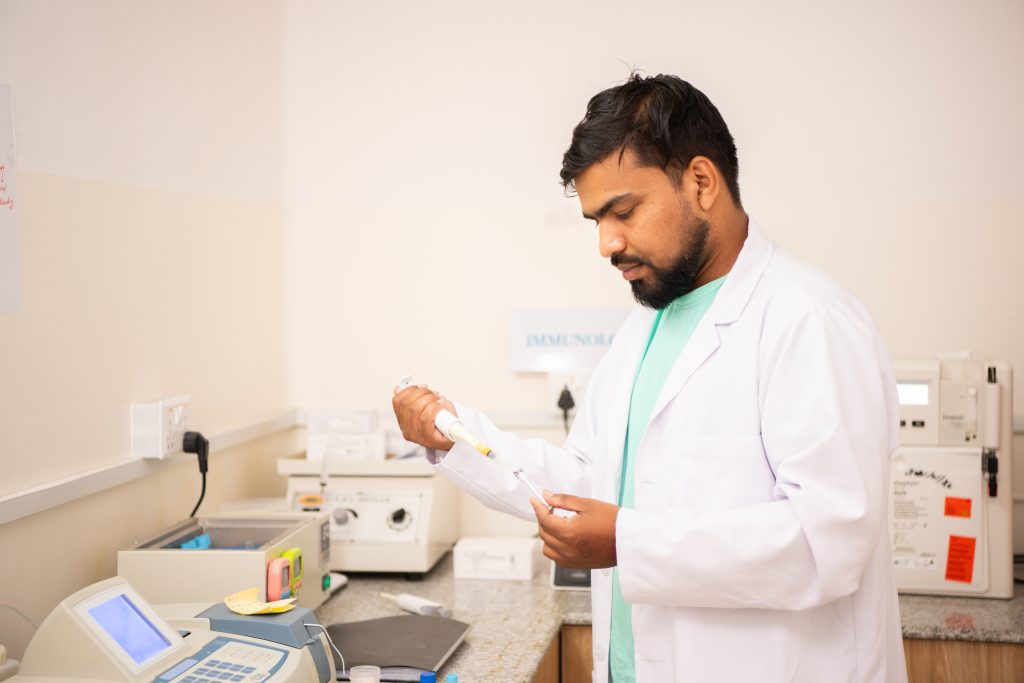
Laboratory Profile

The laboratory of a hospital is a vital and integral part of the healthcare infrastructure, playing a central role in the diagnosis, monitoring, and treatment of patients. This facility is commonly referred to as the clinical laboratory, medical laboratory, or hospital laboratory. The primary objective of the hospital laboratory is to analyze patient samples to provide accurate and timely information that aids healthcare professionals in making informed decisions about patient care.
Key Aspects of a Hospital Laboratory:
1. Sample Analysis:
– The laboratory is equipped to analyze various types of patient samples, including blood, urine, tissues, and other bodily fluids. These analyses help in the detection of diseases, assessment of organ function, and monitoring of treatment effectiveness.
2. Diagnostic Testing:
– Diagnostic tests performed in the hospital laboratory cover a wide range of medical conditions, including infectious diseases, metabolic disorders, cancer, and genetic abnormalities. These tests provide essential information for accurate diagnosis and treatment planning.
3. Clinical Chemistry:
– The clinical chemistry section of the laboratory focuses on analyzing blood and urine to assess levels of various chemical components such as glucose, cholesterol, electrolytes, and enzymes. These tests provide insights into the patient’s metabolic status and organ function.
4. Microbiology:
– Microbiologists in the hospital laboratory study microorganisms to identify and characterize infections. This includes the analysis of bacteria, viruses, fungi, and parasites, with testing for antibiotic susceptibility to guide effective treatment.
5. Hematology:
– Hematological tests are conducted to evaluate the cellular components of blood, providing information about conditions such as anemia, leukemia, and clotting disorders. This section is crucial for understanding blood-related diseases.
6. Immunology and Serology:
– Immunological tests in the laboratory assess the body’s immune response, aiding in the diagnosis of autoimmune diseases, allergies, and infections. Serology involves the study of blood serum and is commonly used for detecting antibodies.
7. Histopathology:
– Pathologists in the laboratory examine tissue samples obtained through biopsies or surgical procedures. This helps diagnose and characterize diseases, particularly cancers, providing essential information for treatment planning.
Laboratory Personnel:
– The hospital laboratory is staffed by a team of skilled and qualified professionals, including medical laboratory scientists, pathologists, phlebotomists, and laboratory technicians. These professionals work collaboratively to ensure the accuracy and reliability of test results.
Quality Control and Assurance:
– Rigorous quality control and assurance measures are implemented in the hospital laboratory to maintain the accuracy and precision of test results. This includes regular calibration of equipment, proficiency testing, and adherence to strict protocols.
Technology Integration:
– Hospital laboratories leverage advanced technologies and automation to enhance the efficiency and speed of diagnostic processes. State-of-the-art instruments and systems contribute to quicker turnaround times for test results, facilitating prompt patient care.
In summary, the hospital laboratory is a cornerstone of the healthcare system, providing essential diagnostic services that contribute to patient care and treatment outcomes. Through continuous advancements in technology and a commitment to quality, hospital laboratories play a critical role in supporting medical professionals in their mission to deliver high-quality healthcare.